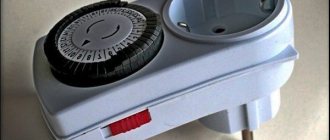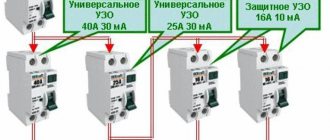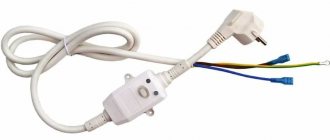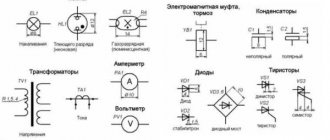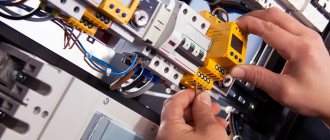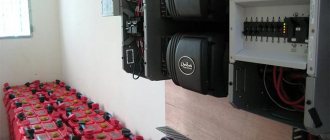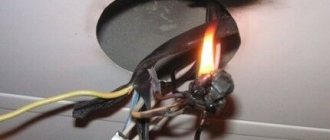Electrician in the house
Encyclopedia about electricity from A to Z
Masters catalog
Find the best master or company in your city
Difavtomats perform a double function (protect against electrical leaks and short circuits) and completely replace the set of RCD and circuit breaker. When choosing a differential, you must consider the following characteristics:
- Circuit breaker rating (A);
- Leakage at which the mechanism is triggered (mA);
- Trip characteristic (“A” or “AC”);
- Type of mechanism (electronic or electromechanical);
- Release characteristics of the machine (B or D).
But how to choose specific values? Taking the opportunity, and not for the first time turning to our electrical engineering expert, I decided to ask him these questions. Namely, the engineer, and part-time specialist in the sale of differential protection, Sergei from the AxiomPlus online electrical equipment store. And this time, although reluctantly, he carried out another educational program.
- How to calculate and determine the right automatic machine for yourself?
- Which release rating should I choose?
- Trip characteristic "A" or "AC"?
- Which type of release should I choose?
- Select the release characteristic of the machine: “B” or “C”
Which release rating should I choose?
Based on the amount of leakage, difavtomats (like RCDs) are divided into two types:
- protecting against electric shock and fire (10-30 mA);
- fireproof (above 30 mA).
As a rule, sockets and lighting are protected by 30 mA diodes (the average person can withstand such a discharge). 10 mA is a safe value and absolutely harmless to the health and life of anyone, even a child. 10 mA difautomatic devices, as a rule, protect bathrooms and children's rooms.
They are not placed on socket groups, since electrical appliances with microcircuits can allow small differential leaks, giving a total of more than 10 mA, to which the differential can react. To protect only lighting or one outlet, this will be enough, the main thing is not to turn on extension cords with a large accumulation of consumers.
At least 30 mA is required at the input. For large houses they install 100 mA, but behind it, using the selectivity method, 30 mA and 10 mA difautomatic devices are installed, since not all people can withstand 100 mA.
What is Difavtomat?
Difavtomat
in electrics (or RCBO, or residual current circuit breaker) is a device that is designed both to protect wiring from overload and to protect a person from electric shock. To make it more clear, let's look at the purposes of devices, a hybrid of which is a difavtomat: a circuit breaker and an RCD.
Circuit breaker
is a device whose main task is to protect wiring from overload. What does this mean? In addition to the secondary characteristics, the machine has a main one - the rated current value. For example, it is customary to buy machines with a rating of 16 amperes per line of outlets. What does 16 ampere rating mean? This means that this device will constantly monitor the current strength and as soon as it notices that the current strength has exceeded 16 Amps, it will open the circuit. Why is it important? But because the wiring and modern sockets are designed specifically for a maximum current of 16 amperes. Consequently, if there is a current in the network for a long time that significantly exceeds this value, the sockets and wiring will begin to melt, which can lead to a fire.
RCD
(residual current device) has a slightly different purpose.
Unlike a circuit breaker, an RCD does not protect wiring from overheating. When you see a 16 amp designation on a circuit breaker, it means that the circuit breaker will simply turn off and open the circuit when the current exceeds the rated current.
When you see a similar designation on an RCD, this indicator means the maximum current value at which the RCD will operate. If the current is greater, the RCD will simply burn out (while the circuit breaker will turn off and remain operational). The main task of an RCD is to control current leakage. By and large, first of all, this means protecting a person from electric shock.
That is, what can we say: The direct task of the machine is to protect the wiring. The direct task of the RCD is to protect people from electric shock.
A difavtomat is nothing more than an RCD and an automatic device in one housing. that is, the difavtomat performs two tasks at once - it protects a person from electric shock and protects the wiring from overload.
Trip characteristic "A" or "AC"?
The more popular “AC” type operates exclusively on alternating current with a sine wave curve. Most often this occurs due to damage to the insulation of household appliances (refrigerators, washing machines, boilers, etc.) when the exposed phase touches the metal body.
But sometimes leaks occur in electrical appliances for which differential protection does not respond. For example, it does not respond to direct or pulsating current generated in electronics power supplies. Nevertheless, “AC” is the simplest and most common differential, and such protection is also 30% cheaper than “A”. As a rule, they are marked on the case with an icon in the form of a sine wave.
“A” is a more sensitive release that prevents any leakage, including pulsating and direct currents, generated in electronics with microcircuits filled with semiconductors (resistors, thyristors, diodes, etc.). This is a more sensitive protection. Marking in the form of a sinusoid on top and two curves on the bottom.
European countries are gradually abandoning "AC", switching to "A", as more reliable and safe. Nevertheless, “AC” can be freely used for electrical appliances without electronic “stuffing”. The instructions for some electrical appliances indicate that they can only be protected by an RCD (or automatic circuit breaker) of type “A”.
Domestic models
KEAZ is a domestic manufacturer of differential circuit breakers and other protection devices. The quality is average, but the products come with a two-year warranty. The price is 1000-1500 rubles for single-phase products.
IEK is also a domestic brand. The products are in great demand due to the successful combination of price and quality. In fact, product shortcomings, such as imperfect terminals, noise during operation, are compensated by the price of 700-1000 rubles for single-phase products.
DEKraft is another Russian brand. The company was formed relatively recently. The quality of the products leaves much to be desired, but at the same time the products comply with Russian standards. The disadvantage is the short service life of the products. Considering the low price (600-1000 rubles), contractors willingly use products of this brand for installation on low-budget projects.
Many manufacturers often produce budget automatic machines, and even entire lines of models with low prices. Therefore, when choosing, it is recommended to carefully study product catalogs.
Of course, when choosing a differential machine, you need to focus not only on price and manufacturer. The operating conditions of the device must be taken into account.
It is possible to use devices with a lesser degree of reliability in utility rooms, where the specific time of use of electrical wiring is small. If the need for such automatic machines is great, then the cost savings can be significant.
Which type of release should I choose?
Based on their internal design, differentials and RCDs are divided into two types: electronic and electromechanical. Contrary to popular belief, the type of release does not affect the operating parameters and technical characteristics. What's the difference between them?
The electromechanical release is triggered by a differential transformer. When a leak occurs in its secondary winding, a voltage appears that acts on the polarized relay, which releases the contacts.
The electronic one is triggered only when there is voltage on the phase. The case contains a microcircuit with an amplifier, powered from an external network. If there is a loss of electricity, the microcircuit sends a signal to the shutdown mechanism, which releases the phase. This scheme is cheaper.
The main difference is that if the network is de-energized, the electronic differential will not work. But is a leak possible in this case? Purely theoretically, yes, due to the energy accumulated in capacitors of electronics connected to the network. These are very rare cases, and rather exceptions to the rule.
On forums you can often find complaints about the reliability of electronic automatic machines, which supposedly do not always work. In most cases, this is due to incorrect connection. According to the PUE, both phase and zero must be connected to the differential protection. If you do not connect the zero, it will work like an automatic machine, but there is no guarantee that it will work like an RCD. Conclusion: if connected correctly, everything will work, regardless of the design of the release.
Foreign models
ABB is perhaps the most famous brand on the market of automatic protective devices, chosen by hundreds of thousands of customers. Owned by a joint Swedish-Swiss company. Currently, production facilities are located in more than one hundred countries.
According to numerous reviews, the company produces some of the best automatic machines. The price can range from 2000 to 4000 rubles for single-phase devices, depending on the parameters and model.
The French product brand LeGrand is widely known throughout the world. This brand is characterized by the presence of a large number of models of manufactured difavtomats, including those for a three-phase circuit. The cost of three-phase automatic machines reaches 10,000-12,000 rubles.
Single-phase ones are comparable in price to the products of the previous brand. It is worth choosing such a differential machine if you prefer European quality.
Schneider Electric is another French brand in the market of protective device manufacturers. In the line of difavtomats there is even a model of a single-phase device the size of one module. Placing production in China made it possible to significantly reduce the price of finished products, and now products from this company can be found on the Russian market at prices ranging from 1,500 to 3,000 rubles.
The Siemens brand is a product of a German company with a long history. It produces many types of industrial and household appliances. There is no specialization in electrical products. Apparently this is why the quality is somewhat lower than that of previous manufacturers. The price of the products is 2000-5000 rubles.
Select the release characteristic of the machine: “B” or “C”
The most popular differential models have the following release characteristics: “B” is the most popular option. Characterized by minimal response delay. Suitable for domestic use in houses with old wiring. Not recommended for networks supplying equipment with high starting currents (washing machines, pumps, refrigerators, concrete mixers, etc.). Short-term excess loads provoke the so-called. false alarm. Instantly triggers at currents equal to 3-5 rated; “C” is a universal option, a good solution for private homes. It has a longer delay before operation, so it does not respond to high inrush currents. It is recommended to select for networks with a large accumulation of powerful electrical equipment running on electric motors. Instantly triggers at a load 5-10 times higher than the rated load.
Type “B” is best used for lines without powerful consumers, and type “C” is more suitable for outlet lines with a load of 1 kW or more.
To maintain selectivity, it is advisable to set “C” at the input, and “B” at the outlet lines and lighting, so that in case of short circuits the input differential does not operate before the group ones.
Calculation of circuit breakers
Before purchasing a difavtomat, it is important to calculate it in such a way as to ensure timely operation and protection without failure of electrical appliances.
Determining the power of the machine
The calculation of the machine according to the power of the electrical receiver is carried out when the wiring along the entire length is designed for a certain type of load. The permissible current in this case will be greater than the rated parameters of the machine.
Calculation of the rated power of the machine
To avoid doing calculations, you can:
- View documentation of household appliances.
- Review the information on the back panel.
- Use the table with average power values of devices.
| Type of electrical appliance | Power consumption, W |
| Washing machine | 2000-2500 |
| Electrically heated floor | 2000-2500 |
| Electric stove | 4500-8500 |
| Dishwasher | 2000-2500 |
| Fridge | 140-300 |
| Mixer | 250-400 |
| Hairdryer | 400-1600 |
| Iron | 900-1700 |
| Vacuum cleaner | 680-1400 |
| Fan | 2500-4000 |
| TV | 125-180 |
| Lighting | 20-100 |
Starting power may differ from rated power.
Rated current calculation
Data on the case of the difavtomat
When calculating the rated current, they are guided by the cross-section of the wire. The rated current of the machine must be less than the maximum value designed for this cable.
The machine is selected according to the minimum cross-section of wires. For example, for a copper cable with a cross-section of 1.5 mm2, the permissible current is 25 A. A machine with a value of 25 A will lead to overheating of the wiring. That's why:
- The power of the loads on the differential circuit breaker is calculated.
- The power of all consumers is calculated.
- A calculation is made using the formula for the design current of the machine I = P/U, where P is the total power of all electricity consumers U is the network voltage.
- The result is rounded.
If wiring has not been done, you can calculate the sum of all devices in the network and select a machine with a rating that matches the calculated result. The wire cross-section must be selected according to the rating of the device.
Determination of time-current characteristic
Special graphs are used to express the time-current characteristics. The curve indicates the response of the machine when the current is turned off. The dependence of the response time of the device on the strength of the current passing through it will be this indicator.
The most common characteristics are:
- B – from 3 to 5×In;
- C – from 5 to 10×In;
- D – from 10 to 20×In.
The letter indicates the operating current.
Unacceptable mistakes when purchasing
The device must be connected in accordance with the specified diagram
. To buy a high-quality automatic machine, it is important to avoid mistakes:
- Installing a device with a damaged housing - dents and cracks lead to breakdowns due to displaced internal components.
- Failed test in the store - the functionality of the devices is checked at special stands.
- Selection of the device is not according to the diagram - the machine will not correspond to the likely loads and will simply burn out.
- Using wires with an inappropriate cross-section - there may be risks of short circuits and burnouts of electrical appliances.
To choose the right differential device, you will need to study the markings, technical characteristics and carry out a test right in the store.
Advantages and disadvantages
The advantage of the difavtomat is its compactness, versatility, 100% protection of the circuit from sudden overloads or other dangers. Well, the main “trump card” is the cost, which is lower than the total cost of the RCD and automatic type switch.
If you take into account a single case, the difference is not very noticeable, but when buying for the whole house, the benefit is significant. However, a lot depends on the brand of the product. Installation takes little time; the difavtomat also fits quite compactly on the rail.
Automats also have their drawbacks. If it fails, you will have to purchase the product as a set, and not separately.
The occurrence of a short circuit will lead to difficulties in finding its cause. With a divided installation, identification is much simpler: the RCD is turned off - leakage, the circuit breaker - short circuit.
Which type of protective device to choose is not an easy question. As many electricians do: if we are talking about a small apartment, then use a difavtomat.
When you are going to install complex structures, it is best to install separate RCD units and automatic type switches in a group. Moreover, each group must have its own separate switch.
